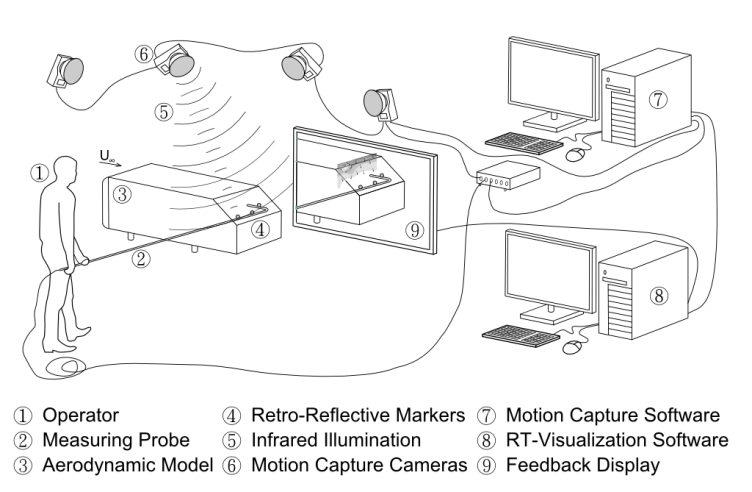Motion Capture of Manually Operated Flow Probes
Andreas Müller, Andrin Landolt, Thomas Rösgen
General Description
Wind tunnel measurements remain an important tool in the testing, optimization and certification process of aerodynamic shapes. In addition to the measurement of the aerodynamic forces acting on the model the investigation of the surrounding flow field is of prime importance. In practice, large scale volumetric flow measurements are rarely carried out largely due to financial and time constraints. Established quantitative methods (e.g. traversing system, PIV) have often proven to be too expensive in terms of setup and measurement time. Hence, simple and efficient but purely qualitative flow visualization tools such as smoke probes and mini tufts are still widely used. Probe capture (ProCap) is an alternative to the standard quantitative methods that attempts to reduce the setup and measurement time significantly by tracking point probes in real-time.
Probe Capture

ProCap is a measurement system capable of measuring time-averaged volumetric flow fields (e.g. pressure, temperature, velocity etc.) in large-scale test sections: A hand-held probe fitted with retro-reflective markers is carefully guided to scan the domain of interest (see figure). The position and orientation of the probe is recorded in real-time using a commercial motion capture system. In the standard configuration, the motion capture system consists of four fixed cameras and a computer calculating the 3D position of the markers based on the four captured images with a spatial accuracy in the sub-millimeter range for a working distance of 2-3 m and latency shorter than 4.2 ms. The data signal of the probe is sampled time-synchronously to the tracking.
The type of data recorded can be selected with an appropriate sensor (e.g. pneumatic pressure probes, hotwire) and can represent any quantity of interest that can be measured fast enough.
Real-Time Flow Visualization
Irrespective of the probe used, visualizing the flow field in real-time reduces the measurement time considerably, because regions containing interesting flow structures are quickly identified and thus the probe can be directed accordingly. For the real-time flow visualization, the probe's position and measured data is continuously streamed to a dedicated rendering computer. On that machine, the flow field is successively reconstructed and a visual feedback to the operator is provided. To improve the efficiency and reliability of the measurement method, different options for flow visualization (e.g. contour and vector planes, streamlines, isosurfaces and a virtual smoke probe) are implemented.
